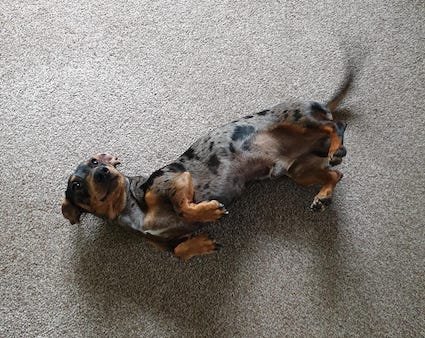Dachshund Training Tips: How To Teach Your Sausage Dog Tricks
Teaching your dachshund tricks is not only a fun and entertaining activity but also a great way to bond with your dog, and as dachshunds are often intelligent and eager to please, they can excel in learning tricks. In this article, we’ll explore effective training techniques, from basic commands to advanced tricks, to help you unleash your dachshund’s potential.
Understanding Your Dachshund’s Behaviour
We have discussed some of the behaviour traits of dachshunds in our previous posts, acknowledging that they are fiercely independent and can often display a stubborn streak. However, dachshunds can be highly trainable when approached with patience and positive reinforcement.
Reward-based training methods, using treats and praise, tend to work best for dachshunds, as does ensuring consistency and routine with your training.
It can help for example to set aside regular training sessions, keeping them short and engaging, to maintain their focus and prevent boredom.
Start With Basic Commands
The easiest command to teach your dachshund, which you can begin practising as soon as you bring your puppy home is “Sit”, and in fact our puppy learned this one within a few days of coming home with us. Once you have taught “Sit”, you can then progress to other basic commands like “Stay” and “Come” (personally, we interchange this one with “Come here” and “Here” which our dog has learned to associate with the same action). All of these commands ideally require you to have some training treats on hand to use as a lure, and are best practised in a quiet, distraction-free area.
-
Use a treat to lure your dachshund into a sitting position, saying “Sit” simultaneously.
-
Reward your dachshund with a treat and praise when they sit.
-
Repeat the process, gradually introducing the verbal cue “Sit” without luring.
-
Apply the same approach for “Stay” and “Come” commands, ensuring consistency and positive reinforcement.

Progress To More Intermediate Tricks
Once they have learned the basics, intermediate tricks such as “Paw”, “Down” and “Roll Over” can add some variety and mental stimulation to your dachshund’s training.
To teach “Paw”, have your dachshund sit, then gently touch their paw while saying “Paw” and reward them when they offer their paw. Some people prefer to use “Shake” or “Shake Paw” in place of “Paw”.
“Down” or “Lie Down” can be taught by luring your dachshund into a down position with a treat, saying “Down,” and rewarding them. This one can sometimes be tricky to achieve as dachshunds are already very low to the ground and therefore can bend their heads to reach the treat without completing the lie down motion, so you can use a raised arm (or leg if you are seated) in a position that would require the dog to lie down to reach underneath, and use the lure to draw the dog under your arm. Be sure to never force your dachshund to lie down and use the arm or leg simply as an obstacle to help encourage the movement.
“Roll Over” is a progression from “Down” and is the most challenging of these more intermediate tricks, In fact it’s still one that we have yet to fully perfect with our boy! The trick is to first master “Down” and then use the treat to guide them to roll over, rewarding them with the treat once they complete the movement.
Advanced Tricks To Help With Mental Stimulation
If you have mastered both the basic and intermediate tricks with your dachshund, there are some even more advanced tricks you can practise to help add further mental stimulation for your dog and variety to your training routines. This includes tricks like “High Five”, “Spin”, and “Play Dead”.
With more advanced tricks, it can be helpful to break down each trick into smaller steps, rewarding your dachshund for incremental progress they make in each training session.
For “High Five,” encourage your dachshund to paw at your hand while saying the command and reward them when they make contact.
“Spin” can be taught by using a treat to guide your dachshund in a circular motion, gradually reducing the lure and reinforcing the verbal command.
“Play Dead” is another variation on the “Down” command, requiring you to start by having your dachshund lie down, then gently rolling them onto their side while saying the command, followed by a reward.
Remember, every dachshund is unique, and the training process may vary, however by using a consistent, patient approach and if you can reduce distraction during training sessions, you can achieve success in teaching your dachshund basic, intermediate and more advanced commands.







